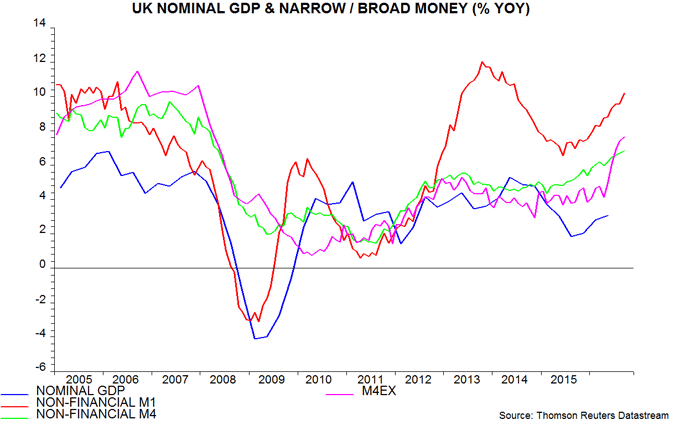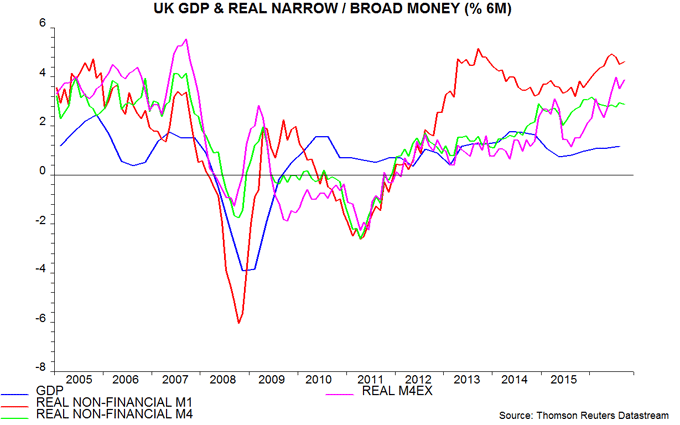UK money trends strong, nominal GDP to accelerate further
The UK economic outlook was uncertain in the wake of the Brexit vote. The provisional assessment here was that the economy would slow significantly but that official / consensus forecasts of stagnation or recession would be proved wrong. This assessment, however, was subject to revision depending on post-referendum monetary trends.
Three months on, it appears that the provisional assessment was unduly conservative. Monetary trends have remained strong since the referendum and suggest rising nominal GDP growth with stable real-terms expansion.
The preferred narrow and broad monetary aggregates here are non-financial M1 and M4, covering money held by households and private non-financial firms. M1 comprises notes / coin and sterling sight deposits; M4 also includes sterling time deposits, money funds, repos and short-term bank securities. These measures grew at annualised rates of 10.5% and 7.8% respectively between end-June, just after the referendum, and end-September. The Bank of England’s M4ex broad money aggregate expanded at a 10.0% rate over the same period, boosted by rapid growth of deposits held by insurance companies / pension funds, unit / investment trusts, other fund managers and securities dealers – movements in such deposits, however, contain little information about near-term economic prospects (hence the preference here for non-financial money measures).
12-month growth rates of non-financial M1, non-financial M4 and M4ex were 10.2%, 6.8% and 7.7% respectively in September. The two broader aggregates are rising at their fastest pace since 2008. Non-financial M1 growth exceeded 10% between May 2013 and June 2014, ahead of several quarters of strong nominal and real economic expansion.
The 12-month growth rates have been trending higher since early / mid 2015. Swings in non-financial M1 growth have consistently led those in nominal GDP expansion in recent years – see first chart. Annual nominal GDP growth rose between the third quarter of 2015 and the second quarter of 2016, and is likely to have increased further last quarter, based on last week’s preliminary real GDP estimate. (A first estimate of nominal GDP for the third quarter will be released on 25 November.) Monetary acceleration suggests that the pick-up will extend into spring 2017, at least.
Faster nominal GDP growth is likely to be driven by higher inflation, with output expansion broadly stable. The second chart shows two-quarter / six-month changes in real GDP and the money measures deflated by consumer prices. Growth of real non-financial M1 / M4 remains strong but has moderated slightly, reflecting a recovery in consumer price momentum. GDP may continue to rise at its recent pace of 2-2.5% annualised through next spring. The consensus forecast of 1.0% growth in all of 2017 (October Treasury survey, revised up from 0.7% in September) looks much too low.


Reader Comments